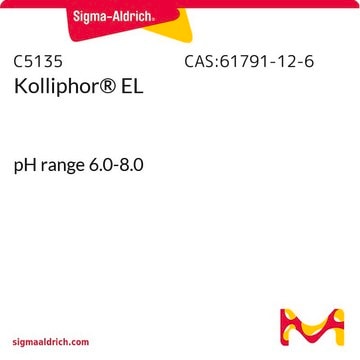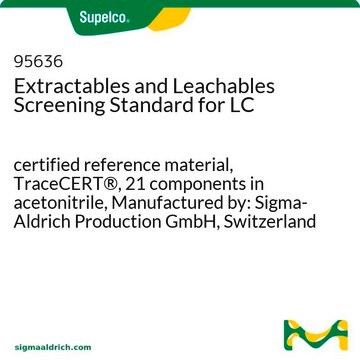If this product has an expiration or retest date, it will be shown on the Certificate of Analysis (COA, CofA). If there is no retest or expiration date listed on the product's COA, we do not have suitable stability data to determine a shelf life. For these products, the only date on the COA will be the release date; a retest, expiration, or use-by-date will not be displayed.
For all products, we recommend handling per defined conditions as printed in our product literature and website product descriptions. We recommend that products should be routinely inspected by customers to ensure they perform as expected.
For products without retest or expiration dates, our standard warranty of 1 year from the date of shipment is applicable.
For more information, please refer to the Product Dating Information document: https://www.sigmaaldrich.com/deepweb/assets/sigmaaldrich/marketing/global/documents/449/386/product-dating-information-mk.pdf
57668
D-α-Tocopherol polyethylene glycol 1000 succinate
BioXtra, water soluble vitamin E conjugate
Synonym(s):
D-α-Tocopherol polyethylene glycol succinate, TPGS, Vitamin E polyethylene glycol succinate, Vitamin E-TPGS
Select a Size
About This Item
Recommended Products
biological source
synthetic
Quality Level
product line
BioXtra
form
powder, crystals or chunks
composition
α-tocopherol, ≥25%
concentration
≥25% (ALPHA TOCOPHEROL)
color
white to light brown
mp
>36 °C
solubility
H2O: 1 g/10 mL, clear to faintly turbid, colorless to faintly yellow
cation traces
Al: ≤5 mg/kg
Ba: ≤5 mg/kg
Bi: ≤5 mg/kg
Ca: ≤5 mg/kg
Cd: ≤5 mg/kg
Co: ≤5 mg/kg
Cr: ≤5 mg/kg
Cu: ≤5 mg/kg
Fe: ≤5 mg/kg
K: ≤50 mg/kg
Li: ≤5 mg/kg
Mg: ≤5 mg/kg
Mn: ≤5 mg/kg
Mo: ≤5 mg/kg
Na: ≤50 mg/kg
Ni: ≤5 mg/kg
Pb: ≤5 mg/kg
Sr: ≤5 mg/kg
Zn: ≤5 mg/kg
storage temp.
2-8°C
SMILES string
CC1=C(C(=C(C2=C1OC(CC2)(C)CCCC(C)CCCC(C)CCCC(C)C)C)OC(=O)CCC(=O)OCCO)C
InChI
1S/C35H58O6/c1-24(2)12-9-13-25(3)14-10-15-26(4)16-11-20-35(8)21-19-30-29(7)33(27(5)28(6)34(30)41-35)40-32(38)18-17-31(37)39-23-22-36/h24-26,36H,9-23H2,1-8H3
InChI key
AOBORMOPSGHCAX-UHFFFAOYSA-N
Looking for similar products? Visit Product Comparison Guide
General description
Moreover, Tocofersolan acts as an inhibitor of P-glycoprotein (P-gp or MDR1) substrate-induced ATPase activity in cell-free assays. It has demonstrated efficacy against resistant K562 cells by binding to urokinase-type plasminogen activator, a crucial enzyme for cancer cell migration and invasion. Additionally, Tocofersolan inhibits tyrosine kinase, a key player in cancer cell development, offering potential applications in metabolomics and biochemical research. Its ability to enhance the absorption of water-insoluble agents and other fat-soluble vitamins positions it as a promising compound for formulation and drug delivery research.
Application
Biochem/physiol Actions
Tocopherol polyethylene glycol 1000 succinate (TPGS) may be used to create biodegradable polymers and antioxidant surfactants.
TPGS exerts anti-tumor activity in MCF-7 and breast cancer cells by downregulating anti-apoptotic proteins.[2]
TPGS finds its application as an emulsifier in the preparation of poly(lactic-co-glycolic acid) (PLGA) particles for DNA labelling, produces particles of uniform size, high encapsulation efficiency, increases hydrophilicity and prevents aggregation of particles.[1]
Features and Benefits
- Can be used in Metabolomics and Biochemical research
- High-quality compound suitable for multiple research applications
Other Notes
Storage Class Code
11 - Combustible Solids
WGK
WGK 2
Flash Point(F)
>392.0 °F
Flash Point(C)
> 200 °C
Personal Protective Equipment
Choose from one of the most recent versions:
Already Own This Product?
Find documentation for the products that you have recently purchased in the Document Library.
Customers Also Viewed
-
How can I determine the shelf life / expiration / retest date of this product?
1 answer-
Helpful?
-
-
How is shipping temperature determined? And how is it related to the product storage temperature?
1 answer-
Products may be shipped at a different temperature than the recommended long-term storage temperature. If the product quality is sensitive to short-term exposure to conditions other than the recommended long-term storage, it will be shipped on wet or dry-ice. If the product quality is NOT affected by short-term exposure to conditions other than the recommended long-term storage, it will be shipped at ambient temperature. As shipping routes are configured for minimum transit times, shipping at ambient temperature helps control shipping costs for our customers. For more information, please refer to the Storage and Transport Conditions document: https://www.sigmaaldrich.com/deepweb/assets/sigmaaldrich/marketing/global/documents/316/622/storage-transport-conditions-mk.pdf
Helpful?
-
-
what is the molecular formula of this product
1 answer-
The exact molecular weight of the product is not determined. The number in the description of the product "1000" refers to the approximate molecular weight of the PEG tail. The molecular weight of D-α-Tocopherol succinate is 530.78.
Helpful?
-
-
Hello, I would like to know how to correctly handle this product: is it required (due to possible inhomogeneity) to melt the entire bottle before dispensing or it is not the case? also, how many melting cycles are safe to be performed?
1 answer-
This product is listed as a waxy solid. Most lots are released as chunks which can be weighed up without melting. However, if small, precise amounts are required, melting to liquify is suitable. The Tocopherol in this complex is esterified and quite stable, however it may be best to aliquot working volumes to minimize reheating. The density at 45 °C is 1.06 g/mL. See the image below to review published information on the thermal stability with repeated heat cycles.
Helpful?
-
Active Filters
Our team of scientists has experience in all areas of research including Life Science, Material Science, Chemical Synthesis, Chromatography, Analytical and many others.
Contact Technical Service











